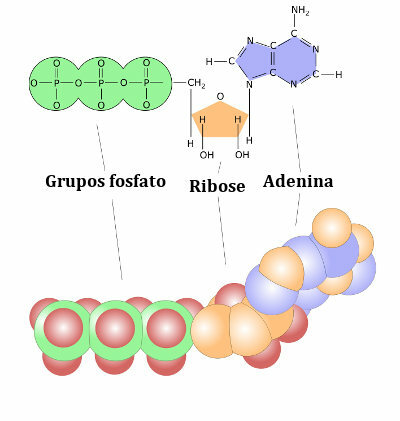When studying the various reactions that take place inside our cells, we often observe the presence of the ATP molecule. But, after all, what is ATP? What is the function of this molecule for a cell?
→ What is ATP?
ATP is an acronym used to indicate the adenosine triphosphate molecule (Adenosine TriPhosphate). This molecule constitutes the main form of chemical energy, since its hydrolysis is highly exergonic. This means that, when undergoing the hydrolysis process (splitting by the action of water), this molecule releases a large amount of free energy.
The ATP molecule is made up of a nitrogenous base adenine, a ribose and three phosphate groups. Ribose-bound adenine is called adenosine. When adenosine is linked to just two phosphate groups, we have the adenosine diphosphate (ADP) and, when it is linked to a phosphate group, it constitutes the adenosine monophosphate (AMP).

ATP consists of an adenosine molecule linked to three phosphate groups.
→ What is the function of the ATP molecule for the cell?
The ATP molecule is critical for the cell, as provides free energy what these cells need to carry out their activities. Thus, this molecule is responsible for ensuring the maintenance of cellular homeostasis, allowing the performance of the various processes that are fundamental for its functioning. It is worth noting that the role of the ATP is not only to function as an energy currency, it is also able to donate a phosphate group to other molecules (phosphorylate).
→ What happens in the ATP hydrolysis process?
As we mentioned before, the hydrolysis process is highly exergonic. In this process, it is produced free energy, plus an ADP molecule and an inorganic phosphate ion, often abbreviated as Pi. The energy released will be used in a reaction endergonic (which consumes energy).
The hydrolysis reaction can be represented as follows:
ATP+H2O → ADP + Pi + free energy
→ Does the reverse reaction also occur?
The inverse reaction can also occur, however, in this case, we will not have an exergonic reaction, but an endergonic reaction, in which energy is consumed. The exergonic reactions that take place in the cell release the energy necessary for the formation of ATP. In the reverse reaction, ATP is formed using ADP and Pi.
ADP + Pi + free energy → ATP+ H2O
By Ma. Vanessa Sardinha dos Santos
Source: Brazil School - https://brasilescola.uol.com.br/o-que-e/biologia/o-que-e-atp.htm
